
UTAR Centre for Mathematical
Sciences (CMS) hosted the virtual 16th IMT-GT International Conference
on Mathematics, Statistics, and Their Applications (ICMSA 2020) from 23 to
24 November 2020. It was held via Microsoft Teams. The conference saw a
total of 50 presentations from 28 local and overseas universities from 11
economies, namely Malaysia, Indonesia, Thailand, Japan, India, Tunisia,
Nigeria, Turkey, the United States of America, Kuwait and South Korea. The
event was sponsored by Tan Sri Dato’ Lim Guan Teik, CorePlus Advisory Sdn
Bhd, Malaysian Mathematical Sciences Society (PERSAMA) and Management
Science/Operations Research Society of Malaysia (MSORSM).
Initiated by IMT-GT
(Indonesia-Malaysia-Thailand Growth Triangle) consortium to promote
mathematics and statistics in the region, the conference aimed to bring
together scientist, mathematicians, statisticians, and academicians from the
region of Indonesia, Malaysia, and Thailand, as well as other regions of the
world to share knowledge, expertise and the recent development of
mathematics and statistics in the form of plenary presentations and
scientific workshops.
Apart from that, the conference
also aimed to engage the latest research trends in mathematics and
statistics, create a platform for the researchers to exchange research ideas
through insightful presentations and encourage cross-discipline
collaborations by expanding research networks.
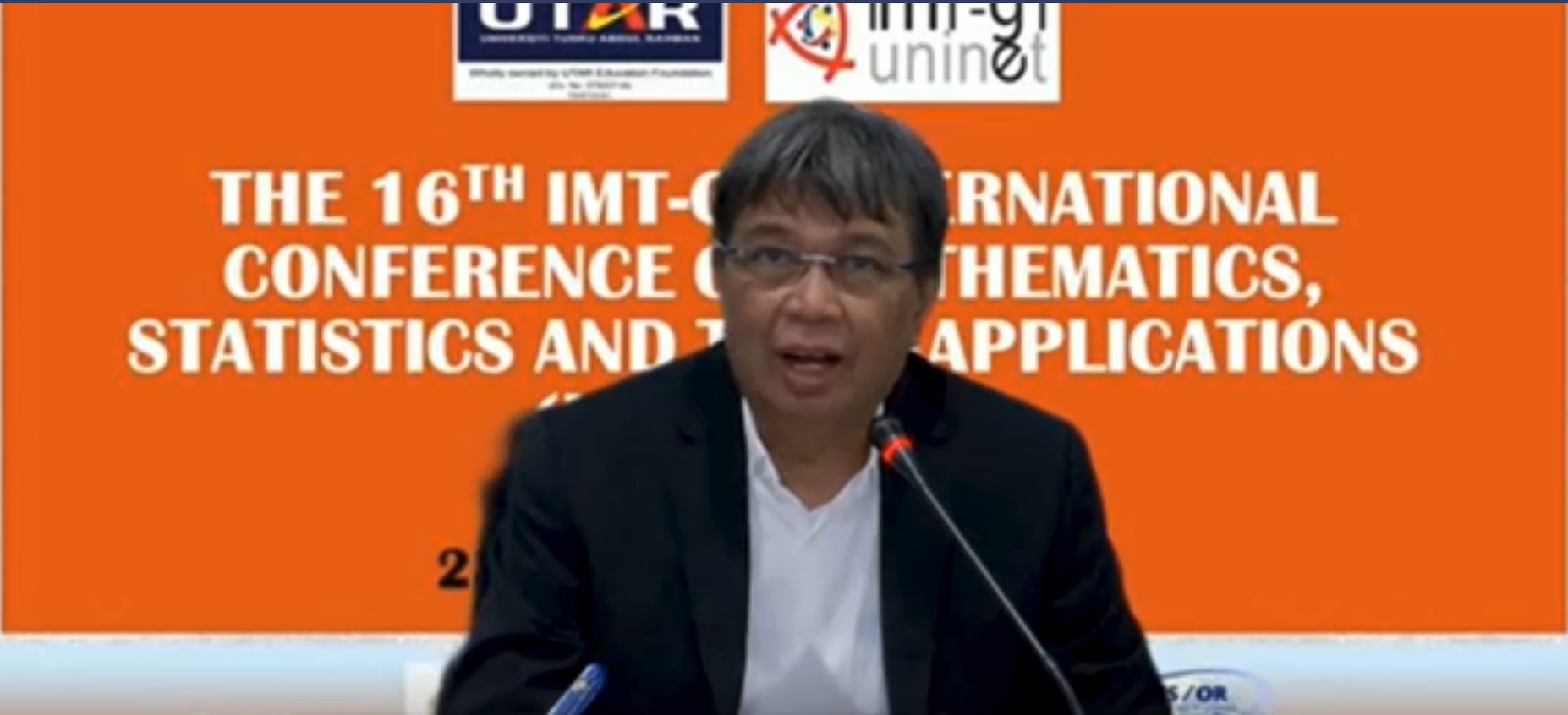
Prof Ewe (left) and
Prof Samsul delivering their speech during the opening ceremony
Prof Ewe said at the opening
ceremony, “UTAR is indeed proud to be given this golden opportunity to host
this 16th International virtual Conference on Mathematics, Statistics and
their Applications. We owe this opportunity to the
Indonesia-Malaysia-Thailand Growth Triangle (IMT-GT) Uninet. A conference
such as this brings together scientists, mathematicians, statisticians,
academicians and researchers from various parts of the world to share their
work, experience and their views and recent developments in mathematical
sciences. Such a wide network of experts in this field coming together will
hopefully kickstart further collaborations and joint efforts to encourage
more of our youths to take up greater interests in maths and sciences and
continue this legacy of brilliant mathematicians and statisticians into the
next generation.”
“IMT GT Uninet has played an
important role to support working groups, joint business council and the
local government. We have successfully conducted the ICMSA conference every
year since 2005. We hope more conferences can be conducted to support the
development of IMT GT especially in the field of human development and
science and technology. This international conference is initiated to
promote mathematics and statistics in the region. This conference is
designed as an annual scientific meeting for all scholars who are working in
the field of mathematics and statistics for Malaysia, Indonesia, Thailand
and other regions in the world to share knowledge and recent development in
mathematics and statistics and its application,” said Universitas Syiah
Kuala, Indonesia Rector-cum- IMT-GT Uninet Chairman Prof Dr Ir Samsul Rizal.

Prof Ewe (top) and
Prof Samsul during the MoU signing ceremony
In conjunction with ICMSA 2020 was
the memorandum of understanding (MoU) signing ceremony between UTAR and
Syiah Kuala University, Indonesia. The signatories were Prof Ewe and Prof
Samsul. Prof Ewe said, “UTAR is indeed pleased to have the opportunity to
continue our collaborations with Syiah Kuala University, Indonesia, as we
look forward to renewing our MoU for another term of five years. We would
like to thank Prof Samsul Rizal, Rector of Universitas Syiah Kuala for his
initiative and his support for our partnership and we look forward to
further collaborative exchanges between our universities especially in
student exchanges, training and research. We hope to explore new ventures
together.”
“We hope to work closely together
and coordinate with the other departments in the areas of student exchanges,
training and research. We invite the engineering faculty to collaborate in
the research next year,” remarked Prof Samsul during the MoU signing
ceremony. The MoU aimed to share expertise and joint development of research
between both universities and exchange publications and academic material.
Besides, both universities are set to facilitate in study visit, staff and
students exchange as well as to participate in scientific discussions and
conferences.
The conference was followed by
research sharing from three keynote speakers, namely King Mongkut University
of Technology, Bangkok Assoc Prof Dr Nuanpan Lawson, Universiti Teknologi
MARA Assoc Prof Dr Adibah Shuib and Institut Teknologi Sepuluh
Nopember, Indonesia Assoc Prof Dr Suhartono.
Assoc Prof Dr
Nuanpan delivering her ideas on her research
Assoc Prof Dr Nuanpan presented
her research titled “Adjusting for Nonresponse in the Analysis of Sample
Survey Data” where she introduced her research and gave example on the
workplace employment relations survey (WERS). She also talked about the
regression analysis at the cluster level, properties of Naïve approach, the proposed method, simulation
study and application to real data.
“In
the cluster sampling, there are two different types of uses for survey data;
descriptive and analytic. There are three types of non-response in sample
surveys which are unit non-response, item nonresponse and under-coverage.
Unit non-response occurs when some respondents choose not are unable to take
part in the study. Item non-response occurs when someone cannot answer or
deny answering some particular questions while under-coverage occurs when
some members of the population are not represented in the sample,” said
Assoc Prof Nuanpan.
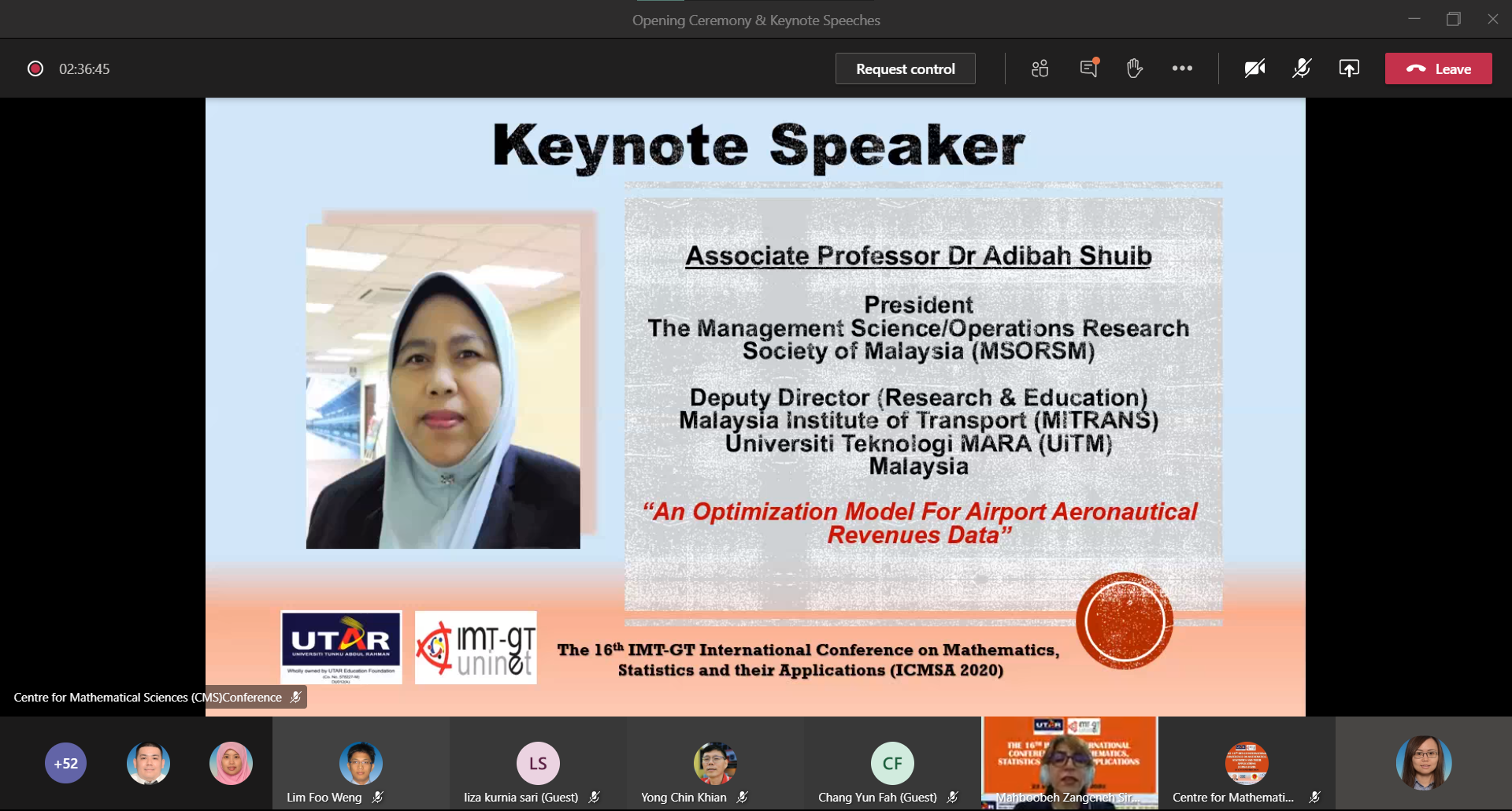
Assoc Prof Adibah’s
keynote session
In Assoc Prof Adibah’s presentation on “An Optimization Model for Airport Aeronautical Revenues” she used operation research (OR) method which is the discipline of applying advanced analytical and quantitative methods to help make better decisions. “It encompasses the development and the application of a wide range of problem-solving methods and techniques applied with the aim to improve decision-making towards more effective decision and many tools can be employed such as simulation, mathematical optimisation, queue theory and other stochastic models,” said Assoc Prof Adibah.
She explained the OR approaches in
air transport industry specifically in airline and airport management in
areas of demand forecasting, fleet assignment, revenue optimisation, crew
scheduling, aircraft routing, air traffic flow management and its system and
many other areas as well. “The research objective is to analyse the current
challenges faced by regional airports and their impacts on aeronautical
revenues; identify airside operations factors that influence regional
airports aeronautical revenues using deterministic approach; develop a
base-line matric using a stochastic approach to analyse the effect of
airside operation factors on generation of aeronautical revenues and develop
mathematical programming model to optimise regional airports revenues while
developing a user interface for airport managers to aid decision making,”
added Assoc Prof Adibah.
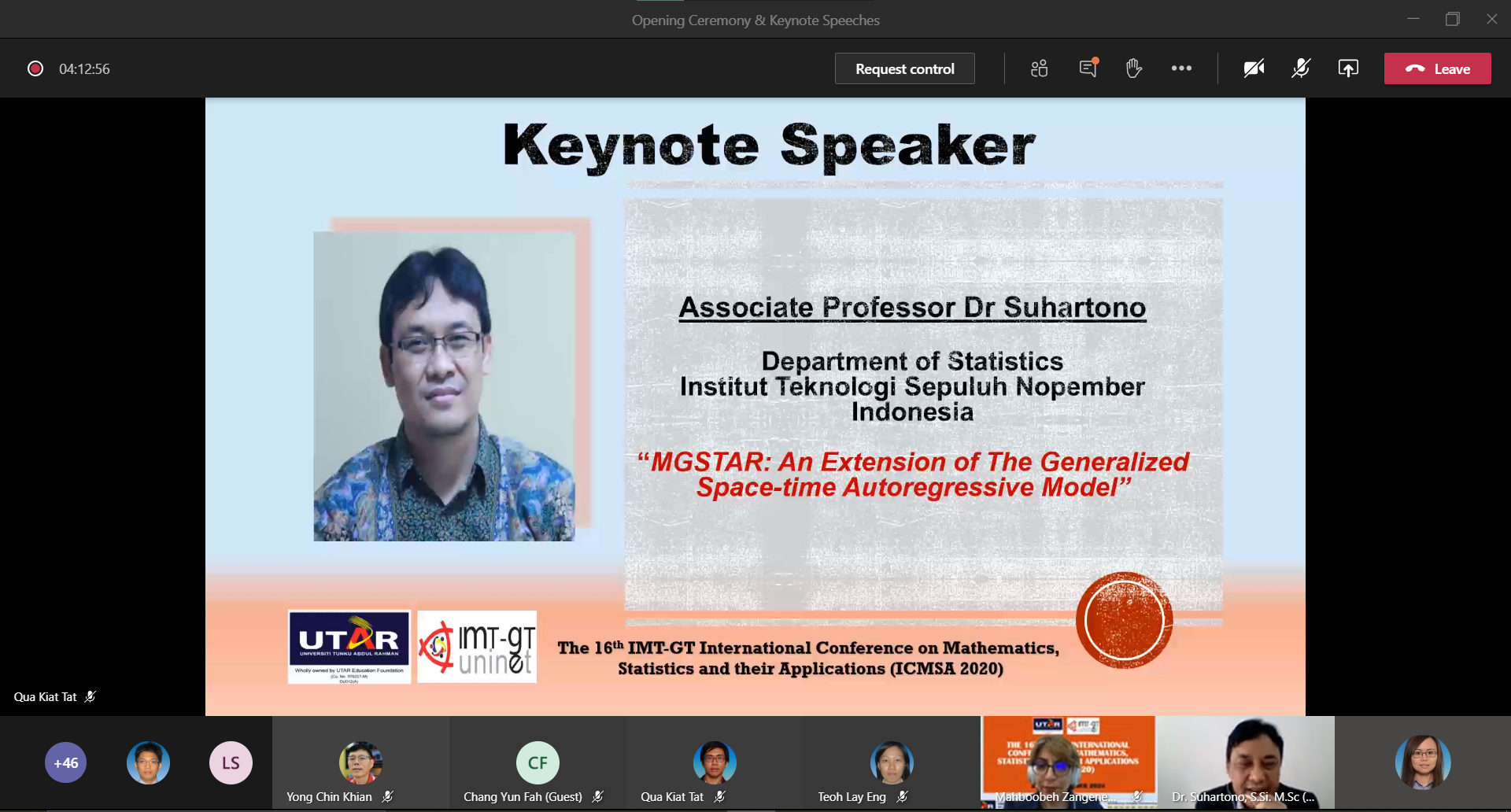
Assoc Prof
Suhartono during his presentation
The third keynote was presented by
Assoc Prof Suhartono. He presented on the “MGSTAR: An Extension of
the Generalized Space-Time Autoregressive Model”. In his presentation, he
spoke about the aim of the research, theoretical framework of Vector
Autoregressive (VAR) and Generalized Spatio-Temporal Autoregressive (GSTAR),
simulation study, the empirical results of air quality in Surabaya and the
future works.
He concluded, “The MGSTAR
parameters can be estimated using ordinary least squares, for both
non-seasonal and seasonal models. The modelling of CO and PM10
uusing MGSTAR yields less accurate forecasts than
the ARIMA model. This result might happen due to a simple autoregressive
order used in the MGSTAR model, while the ARIMA model includes the higher
order of autoregressive. Further research is needed to expand the MGSTAR
model with a higher order of autoregressive, particularly to handle the
trends and seasonal orders. Further method can be proposed by developing
other hybrid linear and nonlinear models or by combining traditional methods
with a machine learning approach to handle the nonlinearity problems.”

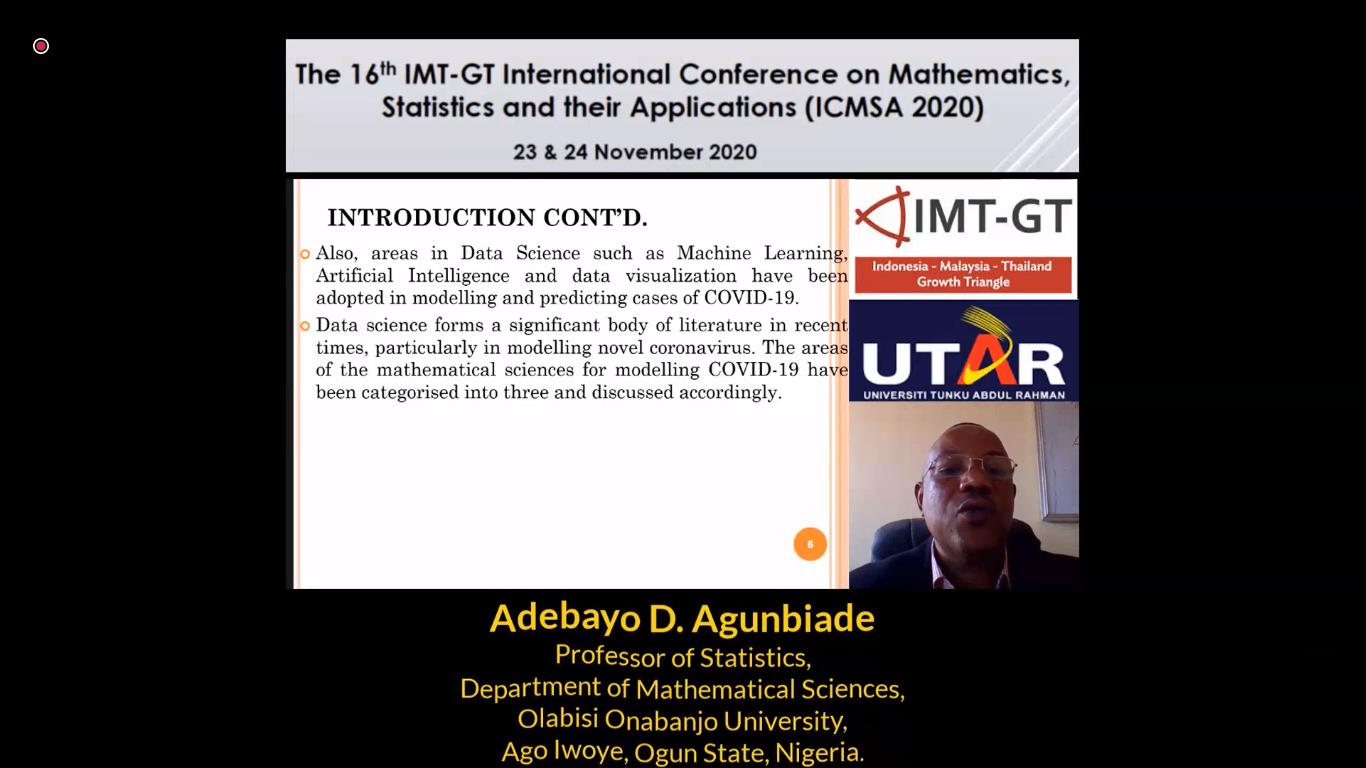
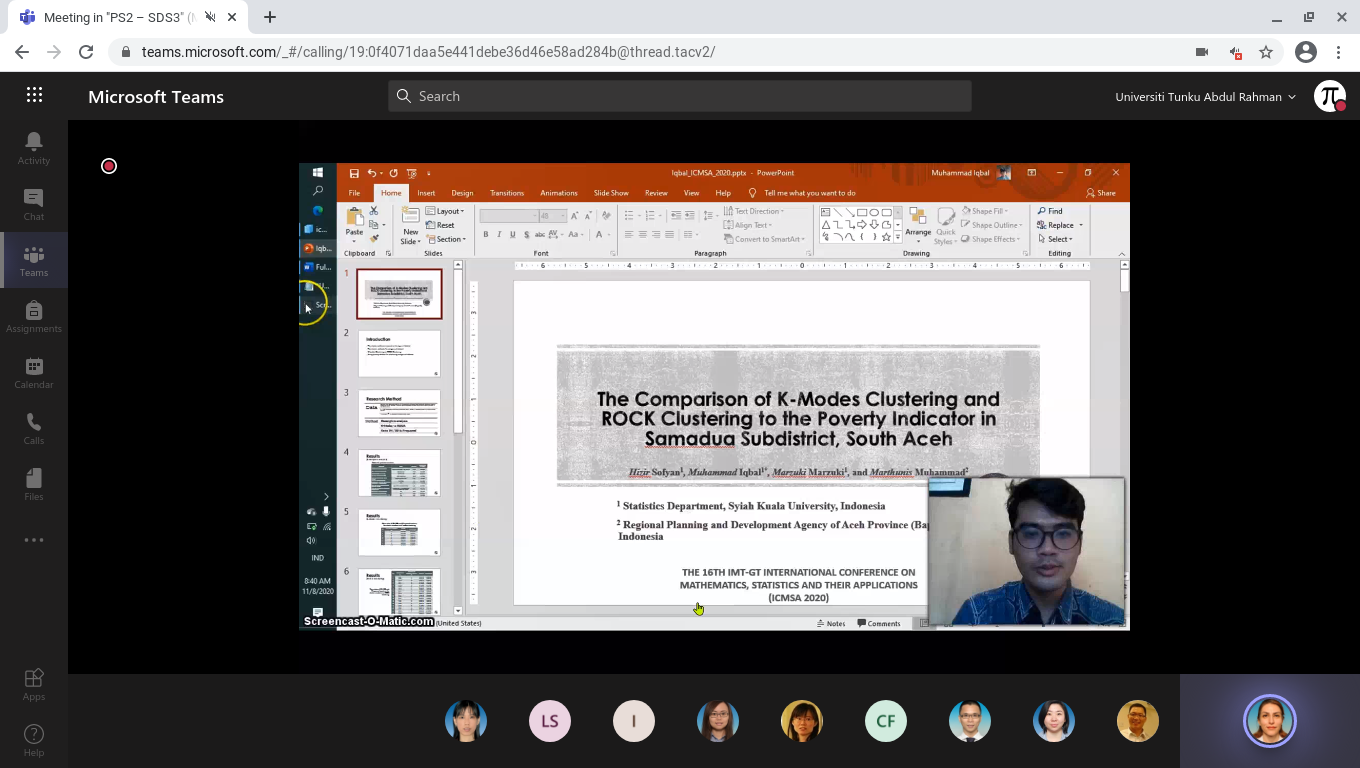
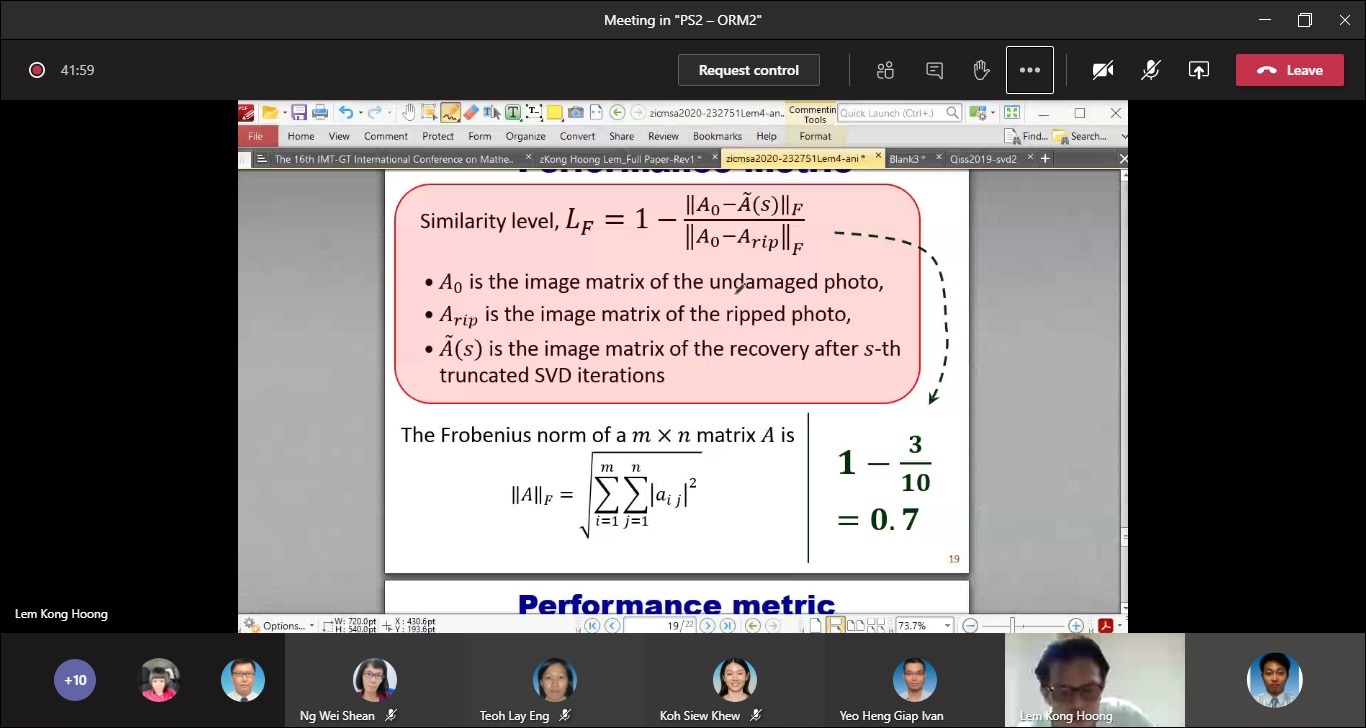
Sharing session
among presenters from different groups
The first parallel session was divided into three groups with different themes. The group session, themed ‘Statistics and Data Science’ consisted of six presenters presenting their paper which included “Statistical modelling of extreme rainfall in Peninsular Malaysia” by Tan Wei Lun; “Bayesian eigenvalue regularization via cumulative shrinkage process” by Masahiro Tanaka; “Modelling extreme precipitation: an application to two selected rainfall stations in Malaysia” by Aida Adha binti Mohd Jamil; “An investigation of three mathematical models on the Covid-19 pandemic: the case of Turkey” by Engin Can; “The asymmetric responses of stock prices in US market” by Beh Woan Lin and “Application of Markov chain in students’ assessment and performance: a case study of School of Mathematical Sciences, one of the public university in Malaysia” by Khairun Husna binti Yahaya.
The second group, with the theme
‘Operations Research/Applied Mathematics’, saw five presenters, namely Yeo
Heng Giap Ivan presenting on “A model of a production-repair inventory
system with time varying demand and quality dependent recovery channels”;
Alfonso E. de la Fuente Ruiz presenting on “Modelling and forecasting second
and successive pandemic rogue waves on planetary scale geometries with
spherical unstructured grids”; Darren Ong Chung Lee presenting on
“Quasiperiodic music”; Aini Janteng presenting on “Coefficient problems for
classes Hq (φ)
and Lq
(φ) and Chong Kah Meng presenting on
“Privacy-preserving healthcare informatics: a review”. The third group, with
the theme “Financial Mathematics” saw four presenters, namely Kuang Kee Seng
presenting on “Universal portfolios generated by rational functions”; Koh
You Beng presenting on “An indicator for month-trading of stocks”; Pang Sook
Theng presenting on “Universal portfolio analysis of Malaysia’s stocks for
different durations” and Lee Yap Jia presenting on “Universal portfolios
generated by an inequality involving the Kullback-Leibler and chi-square
divergences”.
The second parallel session was
also divided into different groups with different themes. The theme
‘Statistics and Data Science’, saw six presenters. Prof Ahmadreza Soltani
presented on “A class of cumulative reward processes: actuarial
application”; Zeinab Jannoo presented on “A structural equation modelling
approach on the influence of job stress among academics at an HEI”; Muhammad
Iqbal presented on “The comparison of K-modes clustering and ROCK clustering
to the poverty indicator in Samadua subdistrict, South Aceh”; Chin Fung Yuen
presented on “The new baseline for high dimensional data set by ranked
mutual information features”; Prof Adebayo Agunbiade presented on “An
integer-valued GARCH model to predict new cases of COVID-19” and Prof Sandip
Banerjee presented on “A mathematical model to elucidate brain tumour
abrogation by immunotherapy with T11 target structure”.
The second group, with the theme
‘Operations Research/Applied Mathematics’, saw five presenters who presented
their research. They were Koh Siew Khew who presented “An
alternative approach in finding the stationary queue length distribution of
a queueing system with negative customers”; Lem Kong Hoong
presented on
“Truncated singular value decomposition in ripped photo recovery”; A'Qilah
Ahmad Dahalan presented on
“Robot path finding with avoiding obstacles in a static indoor mobile robot
via TOR iterative method using harmonic potentials”; Teoh Lay Eng
presented on
“Environmental assessment and improvement strategies for electric bus
operations” and Gillian Woo Yi Han presented on
“Spectral proximal method for solving large scale sparse optimization.
The second-day conference featured the third and the fourth parallel
sessions, talks, as well as closing and awards giving ceremony. The third
parallel session was divided into two groups with different themes. The
group session, themed ‘Statistics and Data Science (SDS)’, consisted of six
presenters presenting their papers which included Moinak Bhaduri who
presented on “Change detection in non-stationary Hawkes processes through
sequential testing”; Ng Jing Wen presented on “A synthetic exponentially
weighted moving average control chart to monitor process median based on the
Ranked Set Sampling”; Seoh Yee Kam presented on “A study on the application
of control chart in healthcare”; Oh Yit Leng presented on “Exponentiated
Weibull Burr type X distribution properties and applications”; Pan Wei Yeing
presented on “Prediction region for average claim occurrence rate and
average claim size in motor insurance” and Ng Kooi Huat presented on “Change
point detection in process control with robust individuals control chart”.
The theme for another group session was ‘Discrete Mathematics (DCM1)’. It
featured five presenters presenting their papers which included “On the
dependence of the component counting process of a uniform random variable”
by Joseph Squillace; “On complete decompositions of dihedral groups” by Chen
Huey Voon; “Total edge irregularity strength of quadruplet and quintuplet
book graphs” by Lucia Ratnasari; “Some properties of various types of matrix
factorization” by Ng Wei Shean and “Rank 2 preservers on symmetric matrices
with zero trace” by Kok Wai Keong.
The fourth parallel session also consisted of two groups with different themes. The group with the theme ‘Operations Research/Applied Mathematics (ORM)’ comprised of two presentations including “Wormholes in exponential f(R,T) gravity” by Prof Pradyumn Kumar Sahoo and “Tension in the dark” by Dr Supriya Pan; while another group with the theme ‘Pure Mathematics (PRM)’ also included two presentations which were “Energy bening slant curves in the 4-dimensional complex projective plane with complex curvature functions” by Dr Changhwa Woo and “On C-parallel curves on some Riemannian manifolds” by Prof Cihan ÖZGÜR.
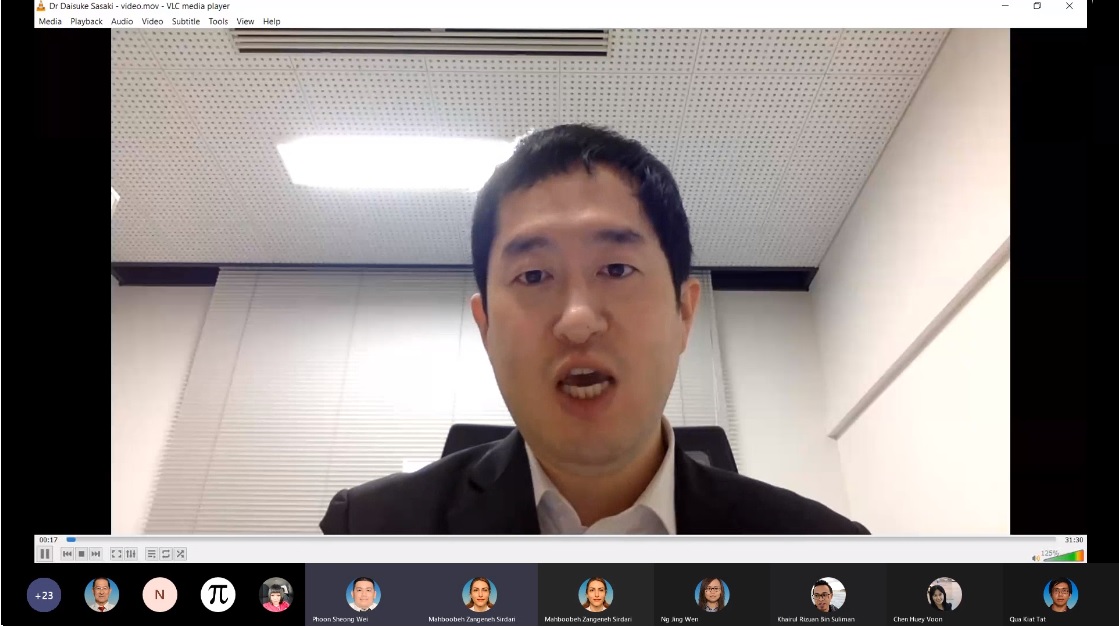
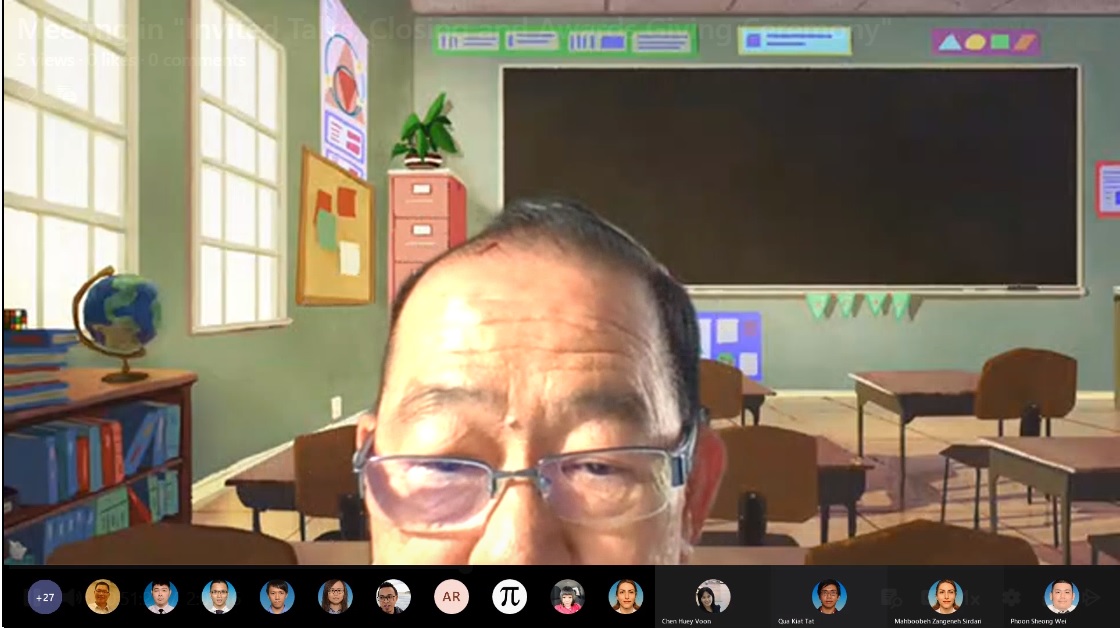
Dr Daisuke Sasaki and Prof Chia delivering their
talks
Following the parallel sessions, a talk was given by Dr Daisuke Sasaki from
Tohoku University, Japan focusing on the topic "Possibility of Utilizing
Disaster Statistic". In his presentation, he first shared some background
knowledge on the statistic of disasters, and then focused on the activities
led by Tohoku University. He also shared three examples of utilising
disaster statistic which included exploratory/confirmatory factor analysis,
proposal of new compound indicators, and text mining approach. The
conference was then continued with another talk titled “How to Square A
Square?”, which was presented by Prof Dr Chia Gek Ling from UTAR LKC FES
Department of Mathematical and Actuarial Sciences. The talk focused on
squaring square, discussing issues on how to subdivide a square into smaller
squares all of different sizes.
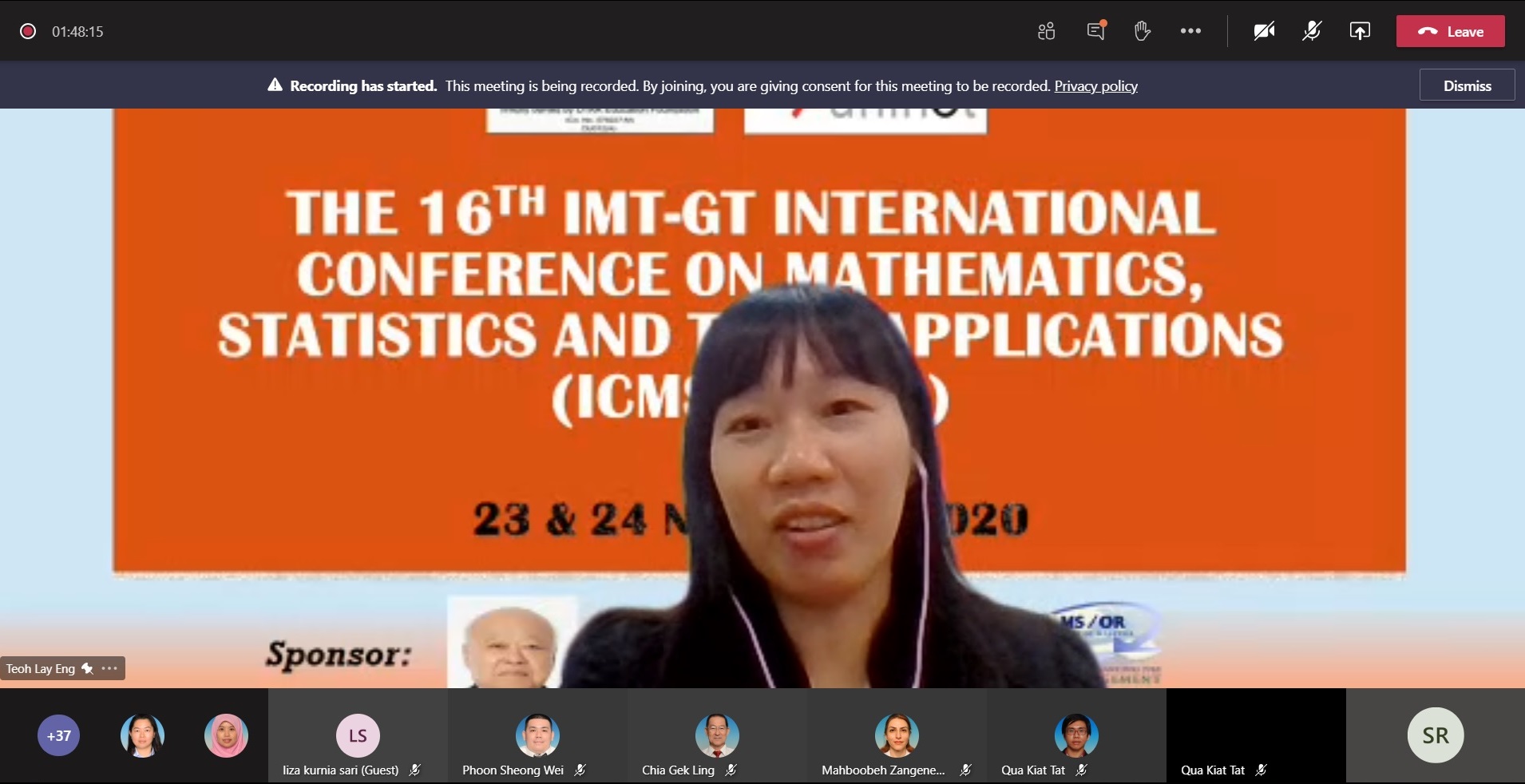
During the award-giving ceremony, ICMSA 2020 Chairperson Ts Dr Teoh Lay Eng
who is also UTAR Centre for Mathematical Sciences Chairperson, represented
Assoc Prof Dr Hizir Sofyan, the Vice Rector of Universitas Syiah Kuala from
Indonesia, to announce the winners for the Best Paper Awards and Best
Virtual Presentation Awards.
The winners are as follows:
Best Paper Award
On complete decompositions of dihedral groups
Huey Voon Chen1*,
and Chang Seng Sin1
1Department
of Mathematical and Actuarial Sciences, Lee Kong Chian Faculty of
Engineering and Science, Universiti Tunku Abdul Rahman, 43000 Kajang,
Selangor, Malaysia
Statistical modelling of bus travel time with Burr distribution
Victor Jian Mingspan
Low1,
Hooi Ling
Khoo1*, and
Wooi Chen
Khoo2
1Universiti
Tunku Abdul Rahman, Lee Kong Chian Faculty of Engineering and Science, Jalan
Sungai Long, Bandar Sungai Long, 43000 Kajang, Selangor, Malaysia
2Sunway University, School of Mathematical Sciences, Jalan Universiti, Sunway City, 47500 Selangor Darul Ehsan, Malaysia
Change detection in non-stationary Hawkes processes through sequential
testing
Moinak Bhadurispan1*,
Dhruva
Rangan1, and Anurag Balaji1
1Department
of Mathematical Sciences, Bentley University, 175 Forest Street, Waltham,
Massachusetts, United States of America
Best Virtual Presentation Award
Truncated singular value decomposition in ripped photo recovery
Kong Hoong
Lem1*
1Faculty
of Science, Universiti Tunku Abdul Rahman, Jalan University, Bandar Barat,
31900 Kampar, Perak, Malaysia
Quasiperiodic music
Darren
Ong1*
1Department
of Mathematics, Xiamen University Malaysia, 43900 Sepang, Malaysia
Change detection in non-stationary Hawkes processes through sequential
testing
Moinak Bhaduri1*,
Dhruva
Rangan1, and Anurag Balaji1
1Department
of Mathematical Sciences, Bentley University, 175 Forest Street, Waltham,
Massachusetts, United States of America
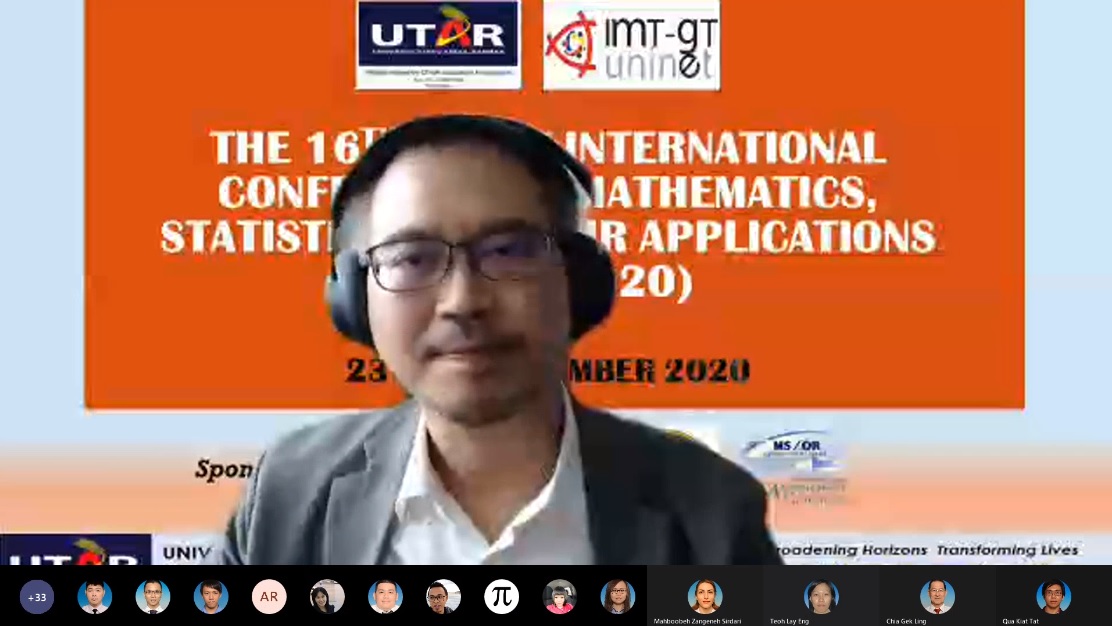
Dr Attachai Ueranantasun delivering his speech
The conference was then followed by a speech given by Dr Attachai
Ueranantasun, the Vice President for Information System and Planning
(Pattani Campus), Prince of Songkla University (PSU), Thailand. According to
Dr Attachai Ueranantasun, ICMSA 2021 will be organised by PSU Department of
Mathematics and Computer Science, Faculty Science and Technology at PSU
Pattani Campus on 13 and 14 December 2021. He gave a brief introduction on
the background of PSU Pattani Campus before ending his speech.
A closing remark was given by Dr Teoh before the conference officially
ended. In her speech, Dr Teoh said, “Today marks a significant milestone,
especially for the conference organiser and also me as the conference
chairperson. As we have come to the end of ICMSA 2020, in spite of many
challenges throughout the year, UTAR Center for Mathematical Sciences is
indeed proud and fortunate to host the conference this year. This virtual
conference is the second IMT-GT Conference for us while our first physical
IMT-GT Conference was held in the year of 2010. We are grateful to IMT-GT
UNINET for the golden opportunity given to us to host the IMT-GT
Conference.”
She mentioned that the conference displayed the amazing diversity of the
applications of Mathematics and statistics, and she said, “During these two
days, I’ve observed your excellent presentation and discussion. I believe
many good experiences have been shared and good lessons learned. Hopefully
what we have learned from this conference will help us to improve and be
better in our work, studies and research.” She also expressed her gratitude
to all keynote speakers, invited speakers, all presenters and parties
involved.
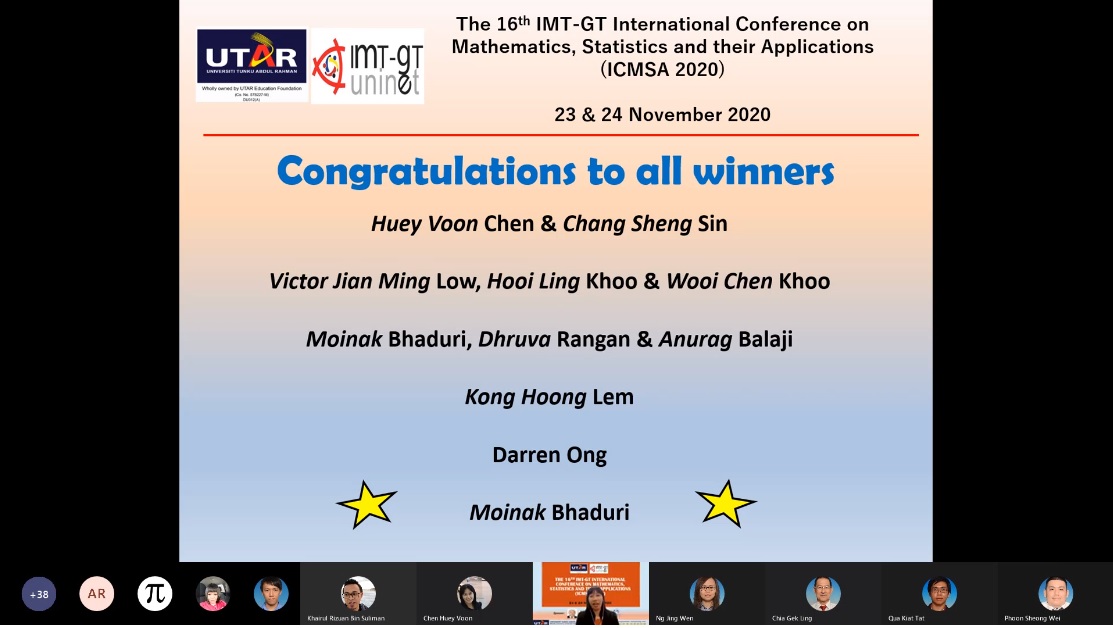
A post-conference scientific workshop was also held on 25 November 2020 which saw two workshops, namely “Python for Mathematicians” and “Statisticians and Elementary Data Analysis using Microsoft Excel”.
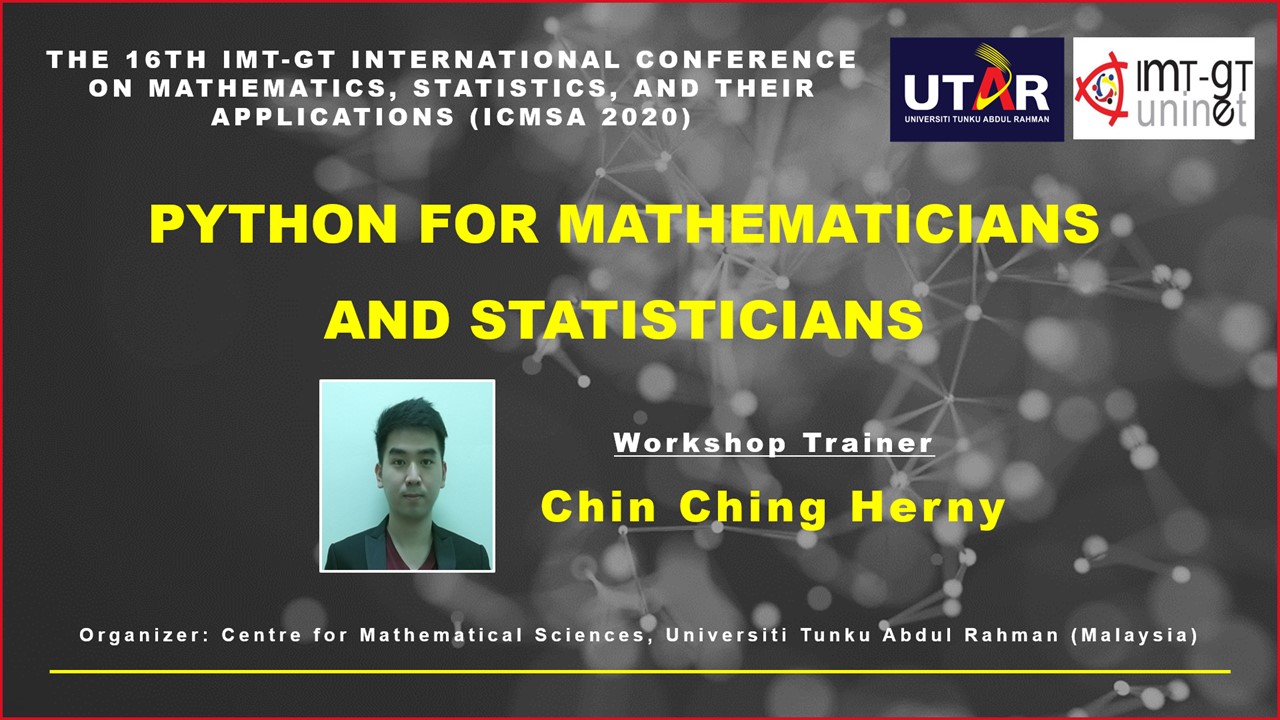
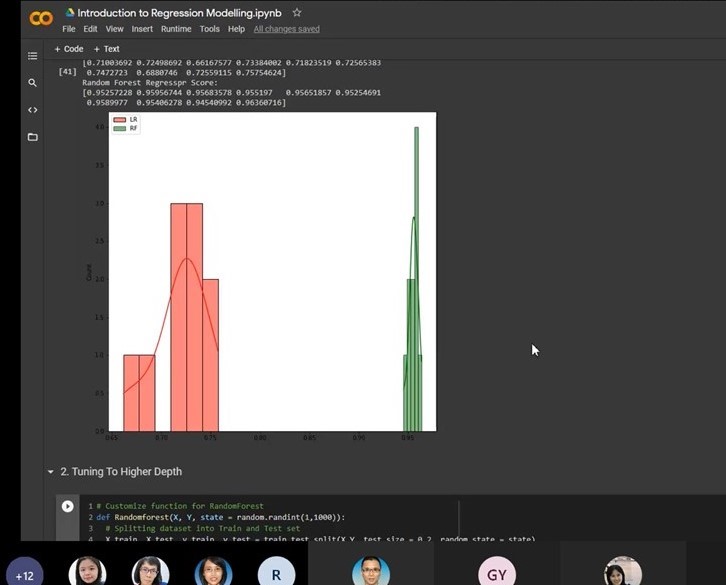
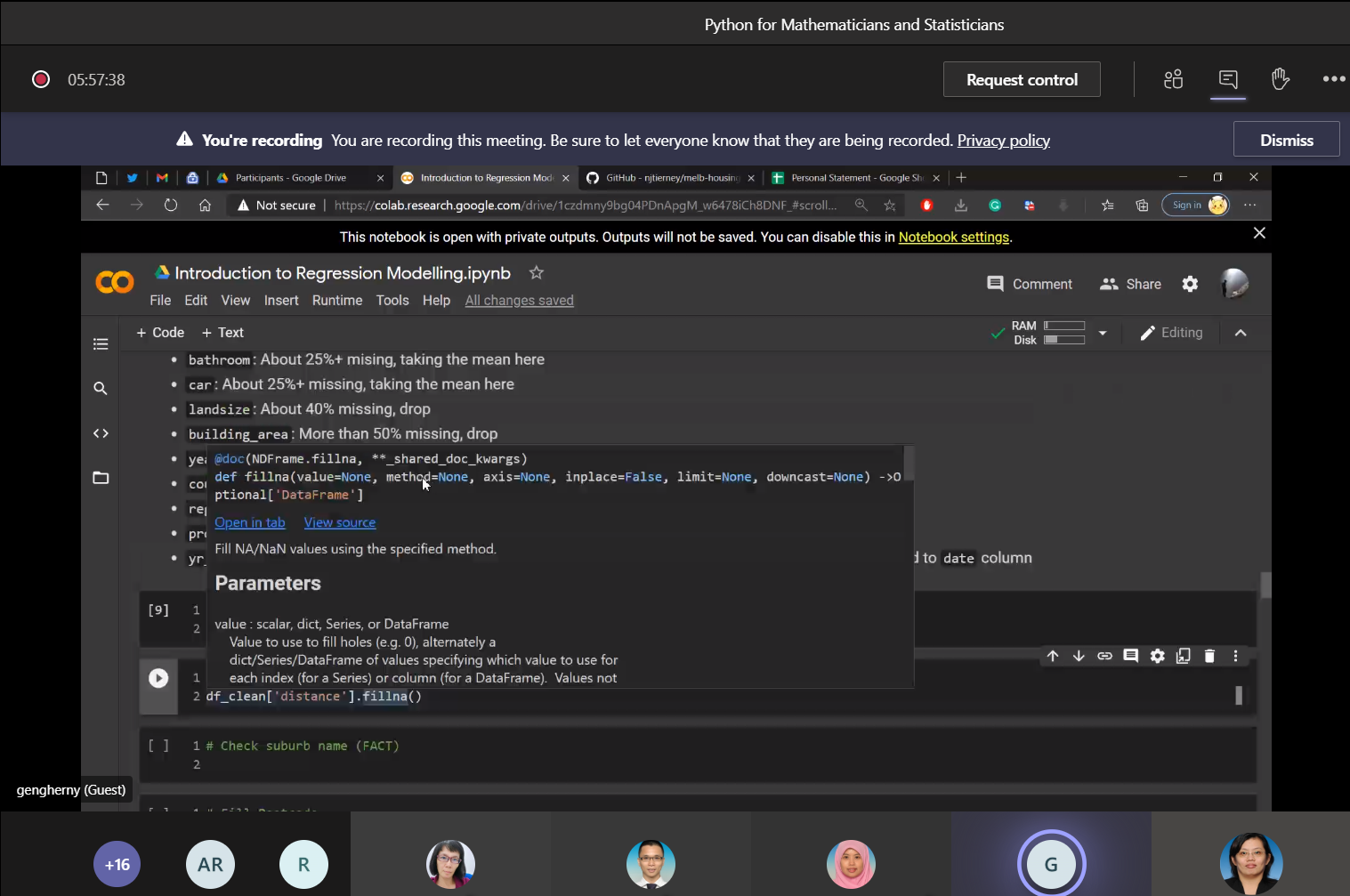
Chin demonstrating
the applied statistical methods
The workshop trainer, Chin Ching Herny, conducted the Python for Mathematicians and Statisticians. He exposed the participants to applied statistical methods and mathematical methods in Python related to research. The participants were instilled with the idea of using Python to achieve their research outcomes as they were taught to build simple statistical models and perform some useful mathematical techniques onto their data. At the workshop, Chin gave an introduction to Python, Linear Optimization and Regression Modelling as well as distribution fitting.
Chin has been an active member in
the Big Data area. He was the Winner of Unlock Asia AI Robot & Big Data
Hackathon 2016; top five winners of MAMPU Open Data Hackathon 2016 and
finalist for Big Apps Challenge 3.0, organised by MDEC in the year 2016. On
top of that, he started to dive into this field by self-exploring various
data analytics tools like Python, R, SAS, RapidMiner, MySQL and AWS EC2 S3.
He has been using Python and R since 2015 not just to complete his research
but also use it for self-interest in web scrapping, dashboard building and
software integration. Apart from that, he has passed a few of the
professional exams from the Society of Actuaries (SOA) which are
Probability, Financial Mathematics and Models for Financial Economics.
The workshop on “Elementary Data Analysis using Microsoft Excel”,
delivered by LKC FES Department of Mathematical and Actuarial Sciences
Senior Lecturer Chew Chun Yong, was conducted simultaneously.
Chew has been working in the actuarial industry before joining academia.
His current research areas are algebra and mathematical physics.
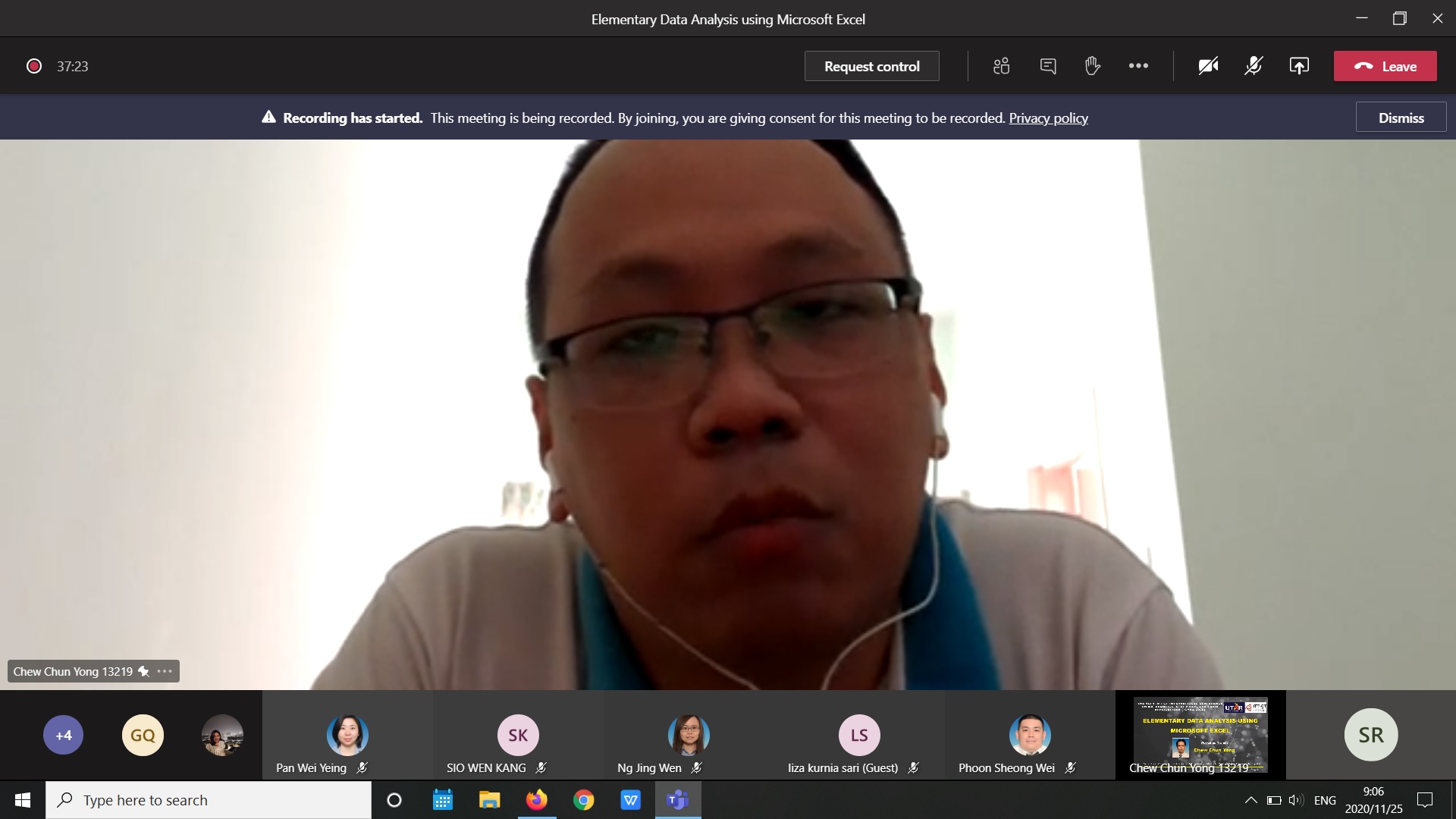
Chew presenting at the workshop
In the workshop, Chew shared with the participants the techniques of performing elementary analysis of a given data set. At the beginning of the workshop, he explained, “It is possible to develop a neural network. In fact, once you understand the algorithm behind it, you should be able to develop almost anything. What we should be considering is efficiency.” He added that building a complicated model using excel from scratch is actually not efficient, especially in the two aspects—efficiency in writing codes and efficiency in compelling the codes.
“We usually do not use excel for large data and complicated models. But
learning Excel has various advantages,” he said. He named a few of the
advantages and said, “However, do not overtrain to use Excel. There are a
lot of Excel users too keen or excited with Excel. They tend to use Excel
for anything, but this is not a healthy behaviour.” The workshop was split
into four different sections, including data and spreadsheet, summarising
using excel function, pivot tables and charts, as well as advance topics.
The participants benefitted a lot from the workshop. They particularly
learned the techniques and how to apply several tools that are efficient in
performing elementary analysis.
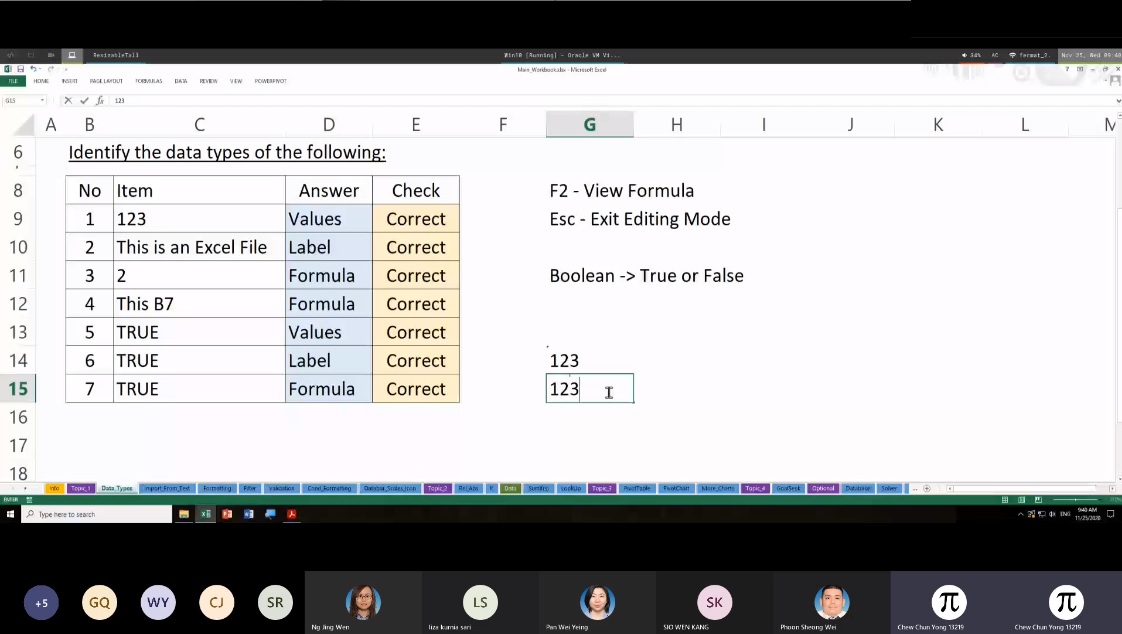
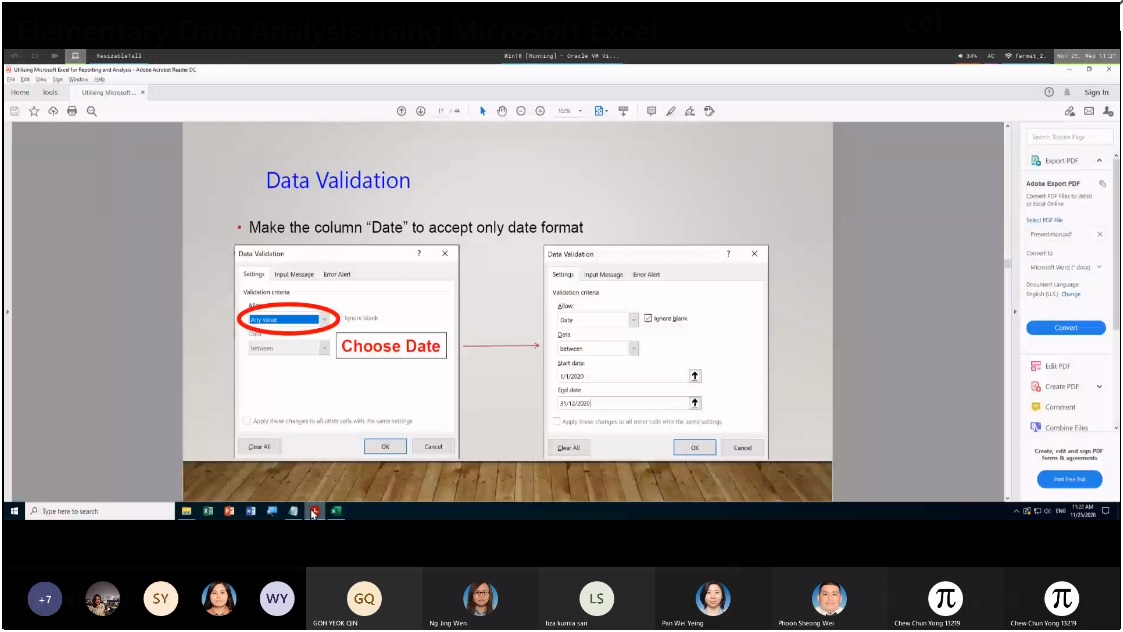
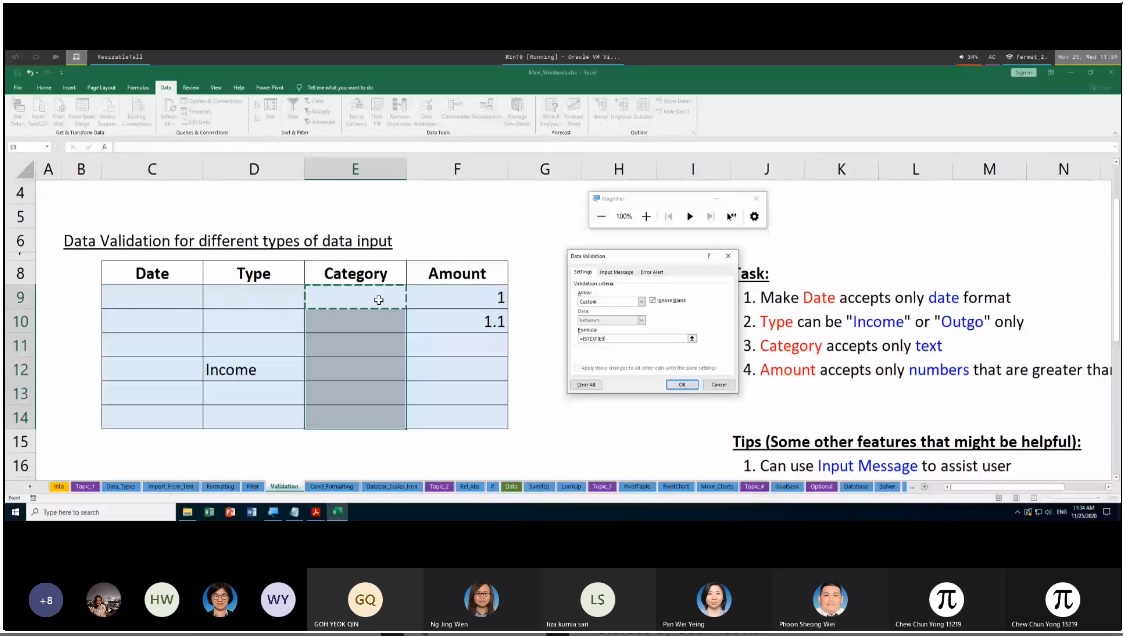
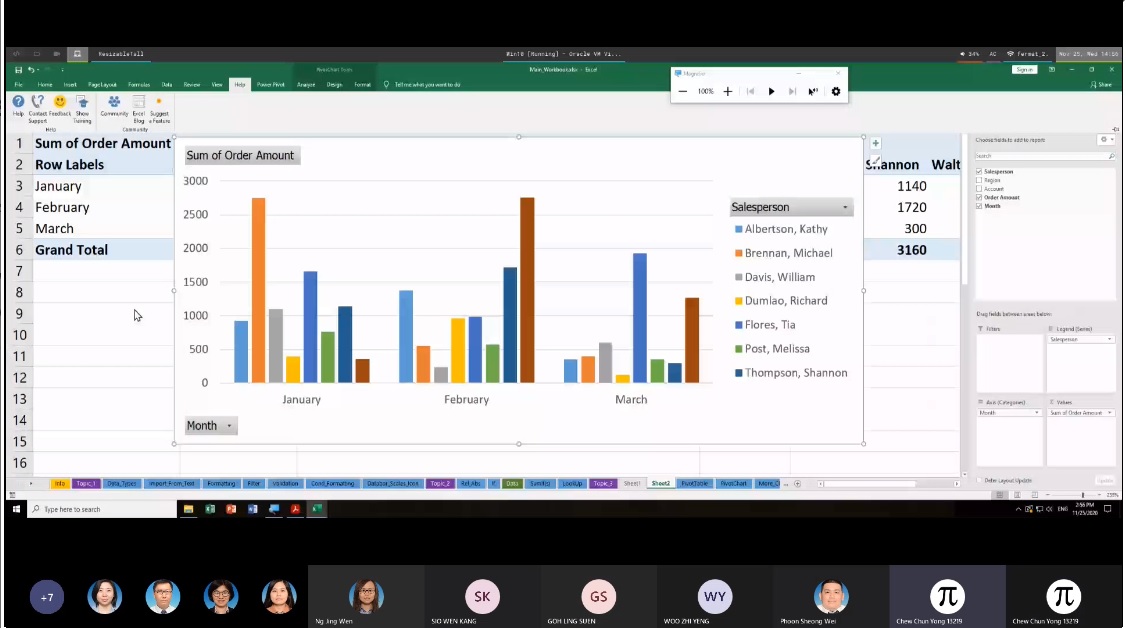
![]()
Wholly owned by UTAR Education Foundation all>Co. No. 578227-M LEGAL STATEMENT TERM OF USAGE PRIVACY NOTICE